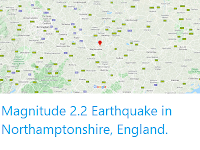The British Geological Survey recorded
a Magnitude 3.0 Earthquake at a depth of 10 km beneath the town of Leighton Buzzard in Bedfordshire, England, slightly after 9.30 am British Summertime (slightly after 8.30 am
GMT) on Tuesday 22 September 2020. There are no reports of any damage or
injuries associated with this event, and nor would they be expected from
such a small event, but many people have reported feeling it in the area.
This is the third Earthquake in the Leighton Buzzard area this month, with a Magnitude 2.3 event having happened on the 13th and a Magnitude 3.5 Earthquake having happened on the 8th. Such clusters of Earthquakes in the UK are sometimes associated with settling at old mineworkings, however, while there is is a history of mining aroung Leighton Buzzard, this is restricted to shallow excavations for sand and gravel for use in the construction industry, and this type of activity is unlikely to cause seismic events of this kind.
Earthquakes become more common as you travel north and west in Great Britain, with the west coast of Scotland being the most quake-prone part of the island and the northwest of Wales being more prone to quakes than the rest of Wales or most of England. However, while quakes in southern England are less frequent, they are often larger than events in the north, as tectonic pressures tend to build up for longer periods of time between events, so that when they occur more pressure is released.
The precise cause of Earthquakes in the UK can be hard to determine; the country is not close to any obvious single cause of such activity such as a plate margin, but is subject to tectonic pressures from several different sources, with most quakes probably being the result of the interplay between these forces.
Britain is being pushed to the east by the expansion of the Atlantic Ocean and to the north by the impact of Africa into Europe from the south. It is also affected by lesser areas of tectonic spreading beneath the North Sea, Rhine Valley and Bay of Biscay. Finally the country is subject to glacial rebound; until about 10 000 years ago much of the north of the country was covered by a thick layer of glacial ice (this is believed to have been thickest on the west coast of Scotland), pushing the rocks of the British lithosphere down into the underlying mantle. This ice is now gone, and the rocks are springing (slowly) back into their original position, causing the occasional Earthquake in the process.
Follow Sciency Thoughts on Facebook.








